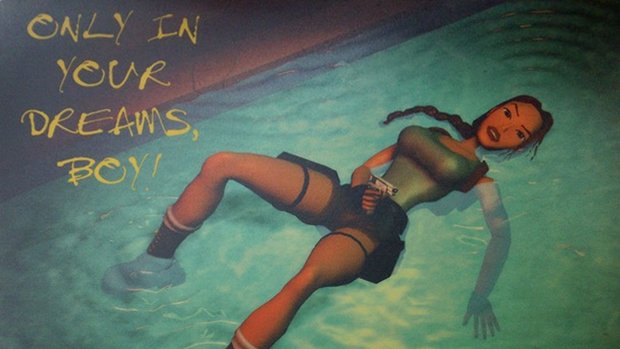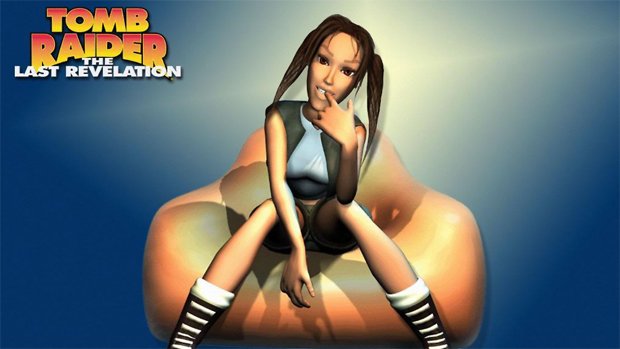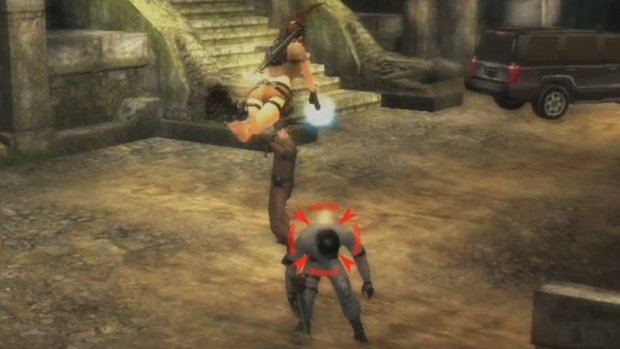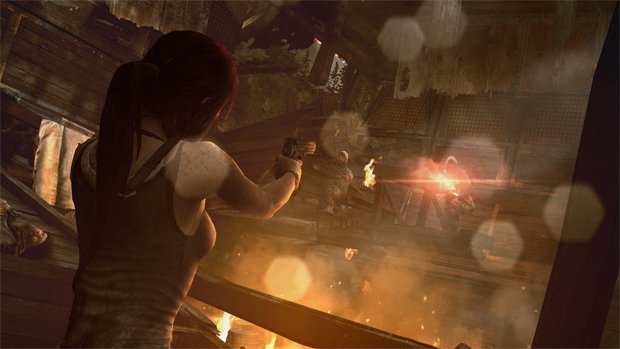Think you know Lara Croft? Don't be so sure...
Two words: Lara Croft. OK, stop there. What did you see? An image will undoubtedly have flashed into your mind. She is, after all, one of gaming's most widely-recognised characters, so you almost certainly have an idea of who 'Lara Croft' is. Yet her appearance and personality have changed so dramatically over the past 19 years, there is arguably no single Lara Croft. And when the next game is called 'Rise of the Tomb Raider', that poses a problem. Who is 'the Tomb Raider'? Who is Lara Croft?
For me, when I read 'Lara Croft', I actually picture this:

Yes, I am showing my age. But that's just my association. Just one interpretation of all Lara's various guises. Who can say which is correct? I mean, take your pick: You've got the classy, brave 'just for sport' adventurer, the low-poly point of historical importance, the comic book star, the Playboy pin-up, the Lucozade CG heroine, the Angelina Jolie Hollywood action hero, the stealthy femme fatale, the gadgeted-up, support team-tastic female Bond of TR: Legend, the vulnerable graduate archaeologist, the high-kicking gymnast, the mass-murderer… the only common traits these characters really have in common is boobs of some description and brown hair. The concept of Lara is now completely nebulous.
It's significant that, despite my love for the haunting atmosphere and feeling of solitude of the original game, the image I associate with the name isn't actually the in-game Lara Croft of the 1996's Tomb Raider - it's more the marketed version of her. On the surface, she is TR1's Lara Croft, sure. It looks like her. It wears her clothes. But it's actually Eidos' marketing department's idea of Lara. And that Lara was turned sexy. I should add that I didn't actually read the edition of Playboy that she appeared in (no, I wasn't 'just looking at the pictures' either – I mean I never saw it), but that sexualised element was pushed massively in the late 1990s. She became the first true virtual pin-up, appearing on everything from lunch boxes to mouse mats.

Looking back now, that all seems incredibly tacky. But if that's what I think, imagine how it must've looked to her creator, Toby Gard, who has consistently said that he wanted none of this sexualisation for his creation. "She was supposed to be this strong woman, this upper-class adventurer," said Gard in an interview with The Independent. "She wasn't a tits-out-for-the-lads type of character in any way. Quite the opposite, in fact." And once Gard saw what Eidos' marketing department was doing to Lara, he actually quit the company. Just two months after the first Tomb Raider's launch.
So we're talking about a major identity crisis right at the start of Lara's life in the public eye. She was intended to be a very British lady. Feisty, yes, but never crude. Sadly, CG characters are essentially puppets and so, as Eidos owned the rights to the character, Lara was literally whatever they wanted her to be and that crept through into the games. By the time Lara's 16-year-old, pigtailed self was dripping wet in flashback sequences in The Last Revelation, it was clear that Gard's Lady Croft was long-dead.

The arrival of PS2 should have offered the core Tomb Raider experience (the first one, that most people still associated with the name), only better, thanks to PS2's more advanced capabilities. But Lara was changing again.
Weekly digests, tales from the communities you love, and more
Sexy or no, the Lara Croft of the 1996 original would never have killed a man in cold blood, yet she started doing exactly that. The Venice level in TR2 was the start, then security guards in TR3. Even though Angel of Darkness tanked, that streak in Lara gained a foothold in her character. And suddenly she became blasé about killing an awful lot of people. It really stands out when you play Legend, despite that game seeing the returning involvement of her creator, Toby Gard. He did admittedly arrive a considerable way into the game's development, but it must surely have stood out to him too. It's certainly not the Lara I knew.

The 2013 Tomb Raider reboot had the opportunity to redress Lara's approach to violence, but it didn't. And I don't think it was that first, controversial scuffle that irreparably broke her innocence. It was the subsequent 400 kills. As that game's writer, Rhianna Pratchett, so succinctly put it: "I'd say from a narrative perspective, we would have liked the ramp-up to be a bit slower, [but] when players get a gun, they generally want to use the gun."
That's a poor excuse. You could give them fewer bullets. In 1996's Tomb Raider, Lara is a similar one-woman army by the midway point (Uzis, baby!), but ammo for the best weapons is scarce, which makes using them so much more special. You could also have more non-human enemies. Again, in the original, she uses those weapons on dangerous wildlife, the undead and - crucially - just a couple of key human foes. If Lara had needed to kill, let's say, three people throughout the new games, each one a few hours apart, the emotional impact from the player's perspective could have been huge. Certainly far greater than the massacre we actually waded through.

This disregard for human life represents a very un-Lara-like personality trait, at least in my view of her. Indeed, the entire series seems un-Lara-like to me. She's following trends. TR3 incorporated stealth when everyone was MGS-mad, Angel of Darkness was 'dark', just as Prince of Persia: Warrior Within was going all emo, and Underworld was (at the time) the closest you could get to Uncharted on an Xbox 360.
1996's Tomb Raider stood out so much because it visibly bucked established trends. Yet Crystal Dynamics has openly said it was influenced by films too. Speaking about Lara's new(est) character, Crystal Dynamics' brand director, Karl Stewart, told PSM3 in December 2011: "We took inspiration of course from the new Batman, but also from the new James Bond [in Casino Royale]. Those are two stories that are new, but have very firm pillars - we know who Bruce Wayne is, we know what he's about, for example. If you look at James Bond, he's a British agent and that he has a license to kill, but if you look at the different time periods of Bond, they always delivered something exciting, and something you look forward to going to the movies to watch. But you can't give those older Bonds to today's audiences."
There it is. Lara is different because the old Lara - apparently - wouldn't be accepted by today's audience. So, returning to that perceived image of Lara Croft I mentioned at the start, she's not only now what countless different people have deemed her to be, but also what some of those people think other people want her to be. She doesn't stand a chance of being herself.

I'm not saying her comparatively realistic current characterisation is poor. It's way ahead of where she was only five years ago. And the reboot is truly a fantastic video game, I adore it. The sexiness isn't too much of an issue any more (although some camera shots are still... awkward). But I do fear that turning the formative Lara into such a killing machine in the 2013 reboot has immediately moved her away from what the 'Tomb Raider' of the new title needed to be.
The name 'Rise of the Tomb Raider' suggests that the definite article 'Tomb Raider' should be apparent by the time the credits next roll. I'm just worried I won't recognise her.
Justin was a GamesRadar staffer for 10 years but is now a freelancer, musician and videographer. He's big on retro, Sega and racing games (especially retro Sega racing games) and currently also writes for Play Magazine, Traxion.gg, PC Gamer and TopTenReviews, as well as running his own YouTube channel. Having learned to love all platforms equally after Sega left the hardware industry (sniff), his favourite games include Christmas NiGHTS into Dreams, Zelda BotW, Sea of Thieves, Sega Rally Championship and Treasure Island Dizzy.



